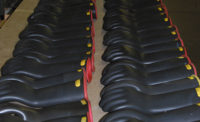Rubber insulating gloves
Maximum use voltage is the one that should be of concern to most users, but it is important to take note of the proof-test voltage as well (see chart). All rubber insulating gloves are tested by the manufacturer at the specified proof-test voltage. Manufacturers also perform a dielectric breakdown test at an even higher voltage, in addition to other tests, to validate the dielectric strength of the rubber material. The result is a significant margin of safety between the test voltage and the maximum use voltage. Your hazard assessment will help you determine which class of gloves is appropriate for your application.
Don’t forget that, with few exceptions, rubber insulating gloves must always be worn with leather protector gloves manufactured in compliance with ASTM standard specification F696. Be aware that there are leather gloves in the market purporting to be rubber insulating glove leather protectors but they do not meet the strict requirements and specifications of ASTM F696. The standard is very specific with regards to the acceptable types of leather (and their thickness), the permissible types of thread stitching, and many other details. Be sure to verify that the leather protectors you are using meet ASTM F696.
One issue often overlooked with regards to rubber insulating gloves in an industrial environment is the retesting of gloves. Rubber insulating gloves are not like safety glasses where you can keep using them until they break. Periodic retesting of rubber insulating gloves should also be performed at the proof-test voltage to ensure that they are still safe. So while some companies may decide to simply throw them away and buy new ones, this is a waste of money considering the gloves can be retested and recertified by a qualified test lab for a fraction of the cost of a new pair.
It is with this in mind that we offer the following FAQ about the in-service testing process for rubber insulating products:
What are the applicable OSHA regulations concerning in-service testing of rubber insulating products?
29CFR1910.137 (b) covers in-service care and use of electrical protective equipment, specifically insulating blankets, covers, line hose, gloves and sleeves made of rubber, and it specifically references the relevant ASTM specifications.
What ASTM specifications apply to the in-service care of rubber insulating gloves?
ASTM F496
What are the testing intervals for electrical protective rubber insulating products?
The interval between date of issue and tests should be based on work practices and test experience. For gloves the interval shall not exceed 6 months except for industries, such as telecommunications, that utilize insulating gloves as precautionary protection, in which case the maximum interval may be increased to 9 months.
What about retesting unused rubber insulating products?
All electrical protective rubber insulating products are tested by the manufacturer prior to first shipment. End users (or end users’ designee) may perform acceptance testing within the first 2 months after receipt. Rubber insulating products shall not be placed into service unless they have been tested electrically within the previous 12 months.
What is involved in the inspection and testing process?
According to ASTM specifications, at a minimum the inspection and testing of rubber insulating products includes check-in, removing previous testing marking, washing using cleaning agents that will not degrade the insulating properties, visual inspection of all surfaces (inside and out), electrical test, final inspection, recordkeeping, marking, and packing in appropriate containers for storage or shipment. “Appropriate containers” means boxes, or similar sturdy packaging materials to prevent folding, creasing, or similar loose storage that can cause stress on the rubber.
Can rubber insulating products be repaired?
While some test labs do perform repairs, it is the opinion of the author and our company that repairing or trimming defective rubber insulating products is not good practice and we will not perform such repairs.
Who is qualified to perform in-service inspection and testing of rubber insulating products?
Many electric power utilities operate their own dielectric test facility to perform acceptance and in-service testing of rubber insulating products. There are also independent testing facilities that can perform the acceptance and in-service testing on behalf of end users.
What is “NAIL” and what does it mean to be a NAIL-Accredited Test Lab?
NAIL (or formally NAILforPET,) formed in 1978, stands for National Association of Independent Laboratories for Protective Equipment Testing. It incorporates the only Laboratory Accreditation for electrical equipment test labs program in North America. Accreditation criteria include laboratory facility, equipment, training and knowledge of staff, and quality control work procedures covering the inspection and testing of electrical protective equipment in accordance with ASTM specifications. Today the NAIL program is recognized throughout North America as an important asset to the credentials of a testing facility.
Two-set program
One recommended procedure to ensure that test gloves are always available is to implement a two-set program. For example, set A is used for six months. Then set B is put into service and set A is sent to a test lab for retest. A similar rotation is done six months later. Test labs usually mark the gloves with a date of test and/or a date to return for test to provide a visual reminder of when gloves need to be retested. To make the program even easier, some companies implement a color-coded glove program. For example, red gloves in the first half of the year and black gloves the second half. This way if a worker is using red gloves in October, a safety director or supervisor can quickly see that the worker is using out-of-date gloves and react accordingly.
Improper use of rubber insulating gloves can be a matter of life and death. Get them retested regularly to make sure that they are still electrically safe. Treat your rubber gloves well and they can last a long time.


